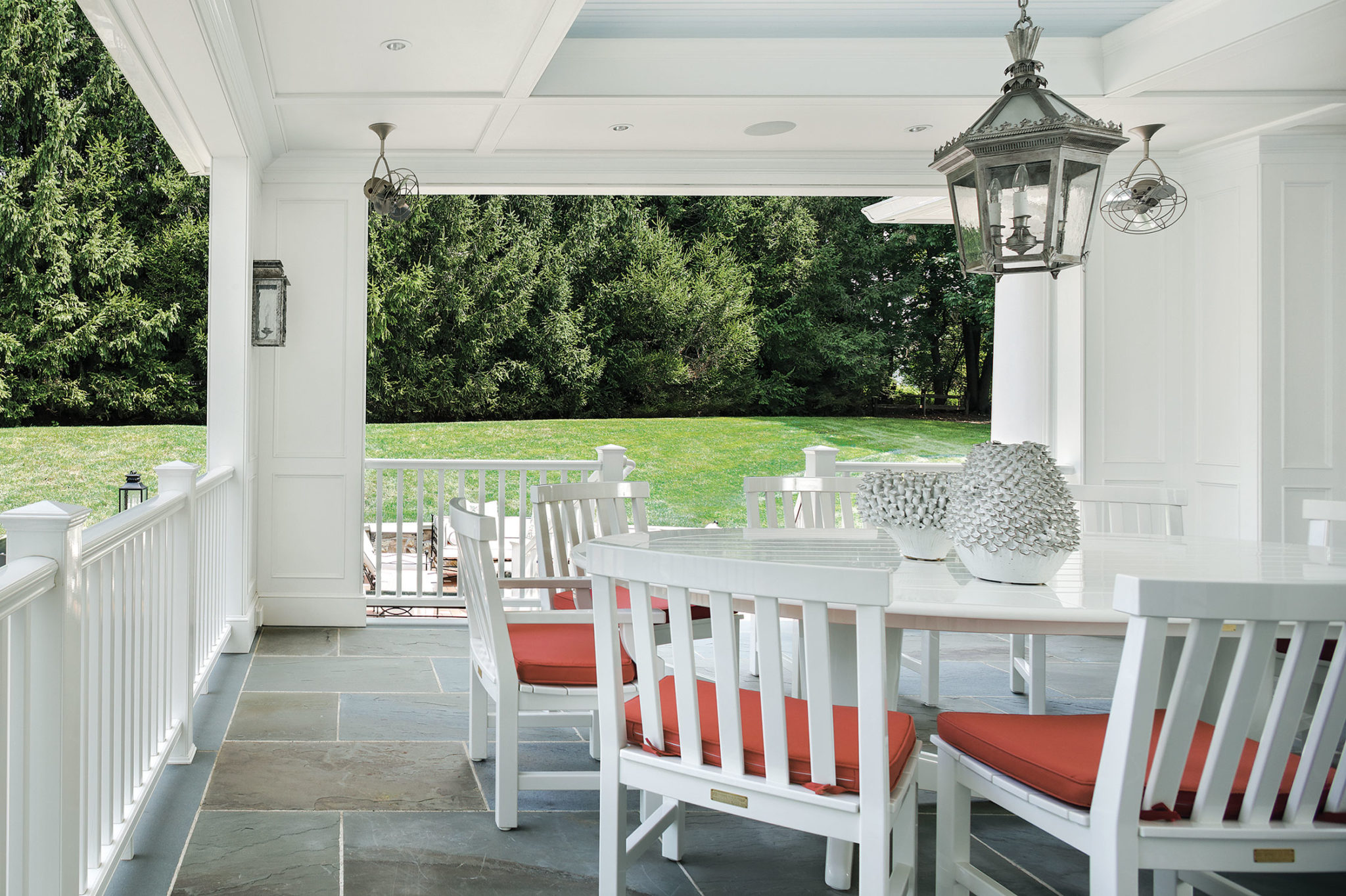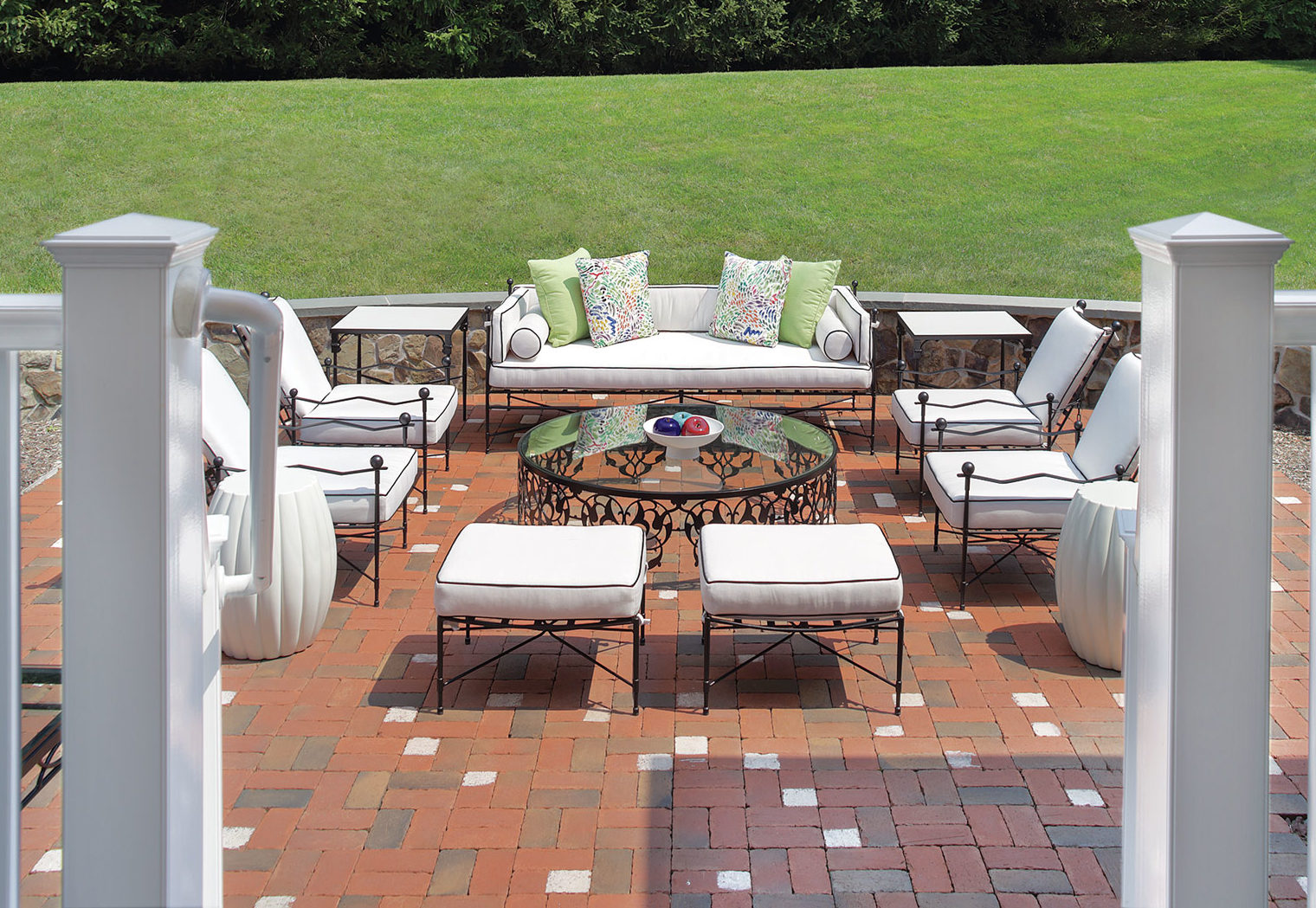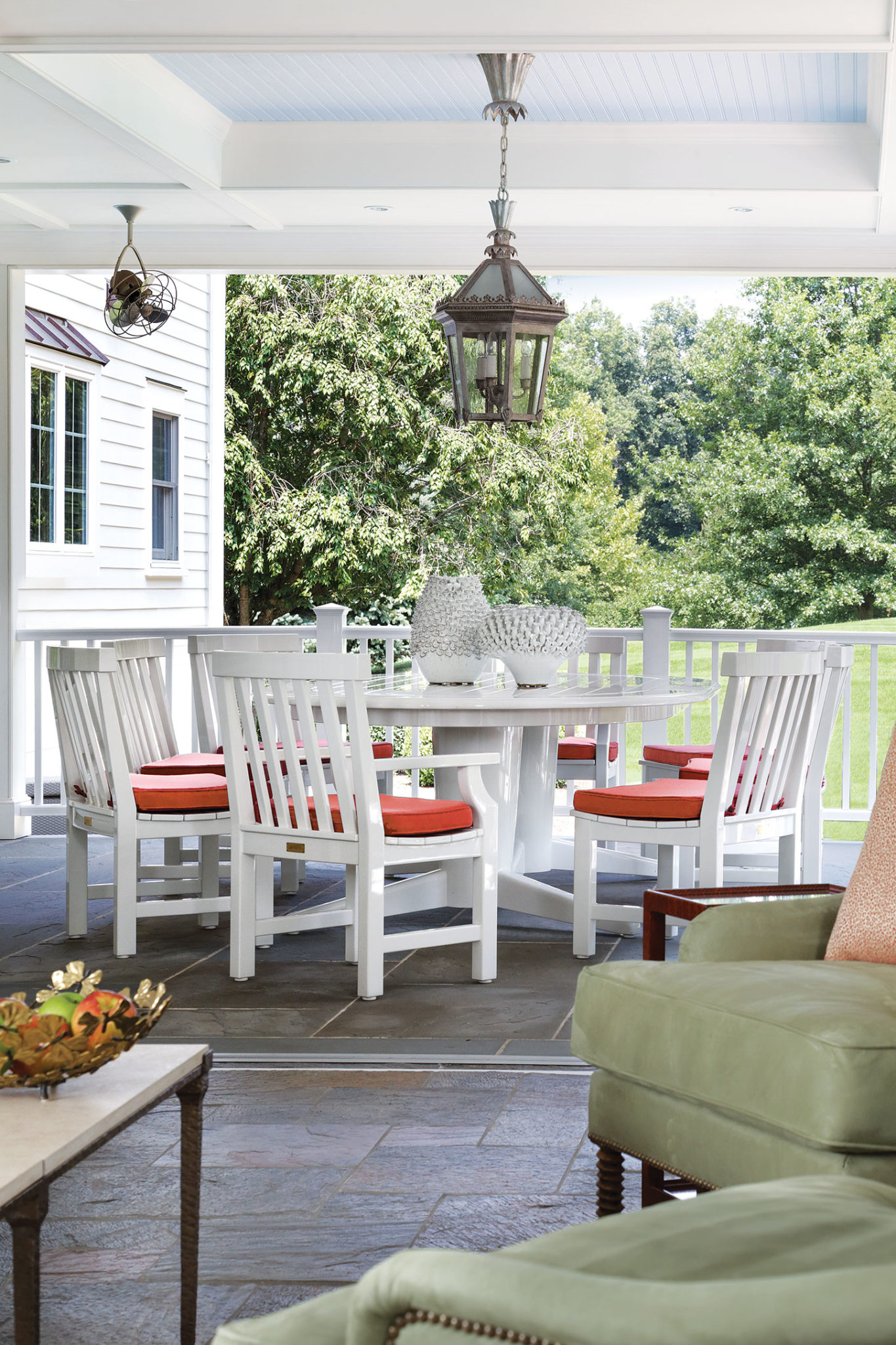A Designer Weaves Colors, Styles and Organic Design in This Outdoor Space
Writer Ren Miller | Photographer Peter Rymwid | Designer Jo Ann Alston, CID, Allied ASID | Architect Hiland Hall Turner, AIA | Builder Brian Cahill Fine Homebuilding | Location Hunterdon County, NJ
Entertaining possibilities abound at this Hunterdon County home, thanks partly to a NanaWall that opens the sunroom to the dining porch. (Note the line in the floor tile delineating the spaces.) Wall and ceiling paneling carries the traditional theme of the sunroom outdoors to the porch, while geranium-coral-hued chair cushions pick up on coral accents in the sunroom.
Colors, styles and organic design weave together a sunroom, outdoor dining porch, and patio in Hunterdon County
Owners may spend hours contemplating how they would like each room in their home to look, but some are more cavalier when it comes to outdoor spaces. If you think about these spaces like rooms, however, you’ll reap the same benefits as you do with well-designed interior spaces: beauty, comfort and function.
Jo Ann Alston of J. Stephens Interiors in Mendham, New Jersey came to the aid of a Hunterdon County, New Jersey, couple who wanted to take better advantage of their wooded lot, adding not only a sunroom but also outdoor rooms. Design NJ published the owners’ sunroom in our April/May 2018 issue (“All About the View,” page 90). In this issue, we share their covered dining porch and a patio.
Alston brought in architect Hiland Hall Turner to work on the dining porch (as she did with the sunroom), including opening the sunroom to the dining porch with a folding glass NanaWall system as well as drawing the exterior structure of the porch, its paneling and ceiling, and the steps leading down to the patio. “We worked together as architect and designer to create the environment,” she notes.
We asked Alston for her thoughts on designing for the outdoors.
Design NJ: What are some top considerations when designing an outdoor room?
Jo Ann Alston: Outdoor rooms should complement the architectural style of the exterior of the home. Also consider sight lines from indoors. Many outdoor rooms are right off a beautiful large window, French doors or, in the case of the Hunterdon County home pictured here, a folding glass NanaWall. If you have a traditional or a modern design aesthetic indoors, you should have a similar design outdoors. You wouldn’t want to see something radically different as you step outside.
DNJ: Does that mean the style of an outdoor room should exactly match the interior rooms?
Alston: I feel the style should blend but not necessarily match the interior. It’s important that the outdoor room in some way relate to the adjacent interiors. If you have a green and pink dining room, for example, you can select green and pink plantings for the outdoor room so it becomes an extension of the dining room. However, we don’t spend as much time in outdoor spaces, so brighter colors and bolder patterns can be fun and not become overwhelming. Bold pattern will draw your eye to the space visually, creating a site line.
The dining porch at this home has the classic lines of the adjacent sunroom. The geranium-coral-hued cushions echo pops of coral in the sunroom. The patio is more European in style with low-slung metal furniture, but the white cushions with black piping relate to the white table and chairs on the sunporch. The Moroccan table on the patio works in this setting because everything else is streamlined. It is the unexpected element that adds a note of interest and surprise. It’s all in the art of the mix.
DNJ: Other considerations?
Alston: Think about scale. A small patio wouldn’t look right on a large home. If you have a large backyard, you may want to create different spaces. In this project, we replaced a deck with the covered dining porch and added steps leading down to the brick patio. One trick I use when designing outdoor spaces is to create boundaries—for example, low walls or planters in the four corners—to delineate the space and help you to feel less exposed. Containers with tall plants give you the feeling that you’re in a courtyard.
DNJ: It seems easiest to select an entire set of outdoor furniture from a single company. Is that a good idea?
Alston: Purchasing an entire collection looks like you simply bought everything off the showroom floor. I like to add an organic feel and, just like with interiors, add unexpected materials. You want to mix it up to make your outdoor room more interesting. In my designs I like to create vistas so that when someone looks through a window from inside the home, they want to go out and enjoy the outdoor spaces.
DNJ: Do I have many choices in furnishings that stand up to the weather?
Alston: These days there are many choices; you literally can furnish an outdoor room in any style.

Steps lead from the traditional dining porch to the patio, which has a more Mediterranean feel. The colors tie the outdoor spaces together and to the sunroom.
DNJ: What are some tips for choosing materials for outdoor rooms?
Alston: For flooring, the material should blend with the exterior of the home. The dining porch and patio at this home are on a property that includes a bluestone walk, so we chose bluestone for the dining porch floor. It also complements the slate floor in the sunroom when the two rooms are open to each other. If you have a home in the mountains or at the shore, you have a different vibe and may want to use different materials. It is important to choose flooring that has texture to it so it is slip-resistant.
For furniture, mahogany and teak are good choices for wood, and aluminum and powder-coated stainless steel for metal. The wood furniture on the covered dining porch shown here is Weatherend® Estate Furniture, a company that uses the latest yacht-building techniques with proprietary innovations. Keep in mind that if you use wood furniture in an uncovered space, you may have to refinish it at some point. The Amalfi Living furniture on the patio is weather-resistant powder-coated stainless steel.
Another material we use is Glassos®, which is crystalized glass. Glassos is made by fusing a proprietary blend of quartz and other minerals using heat rather than epoxy. It replicates Thassos granite. In this project, I used Glassos for the tops of tables on both ends of the patio sofa.
The content of cushion and pillow fabrics used outdoors hasn’t really changed since they were introduced, but the design has improved so much that we have clients who want to use them indoors, for example, in the kitchen. These synthetic fabrics are durable and highly cleanable, but remember they are not impervious. Four years down the road, the fabric may not look as pristine if it was left out in the sun and rain. Make sure your cushions are made of flow-through (perforated) foam. When it rains, the water flows through the cushion rather than sitting inside of it.
DNJ: What interior details that you might not think about putting outdoors will work equally well either place?
Alston: In this project, the sunroom has real wood paneling. It was important to continue the look to the dining porch on the other side of the NanaWall. We did that by adding paneling on the walls of the dining porch, as well as base and crown molding, all made of Azek,® a weather-resistant engineered polymer. We added a tray ceiling with a blue bead-board inset over the table. The bead-board is a nod to the turn of the last century, when it was often used on porch ceilings.
Rugs also make an outdoor room feel like indoors. There are a lot of beautiful outdoor rugs today.
Accessories will give the room a finished look. The vases on the dining porch and fruit on the patio table will withstand the weather, and they’re pretty enough to bring indoors to use in the sunroom.

The chandelier and custom sconces (one shown) have a silver finish that picks up on cool colors in the bluestone flooring of the dining porch. Vases on the table add an organic element to the porch, which features wide-open views of the heavily wooded lot.
DNJ: What should I look for in furniture that is both comfortable and durable?
Alston: Go with a reputable manufacturer. I like to stay with American-made furniture that comes with a warranty. It’s also a good idea to sit in the furniture before buying. Each family member may find something different to be comfortable, so sometimes you have to choose a happy medium. A smaller family member may need to add a cushion behind them for support. For a larger person—perhaps a football player—you need to consider the chair’s weight-load capability for the safety of the person and the durability of the chair.
DNJ: What are the main considerations when lighting outdoor rooms?
Alston: Lighting an outdoor room is similar to lighting a room indoors but with additional considerations. I like to accommodate different moods and levels of lighting indoors and out. You may want all the lights on, you may want most of them off, you may want them dimmed. In the case of the Hunterdon project, we have lights controlled by a Lutron system. Small LED downlights illuminate a pathway around the perimeter of the dining porch so people can move around safely. A chandelier above the table lights the entire space and, together with sconces, creates the feel of an indoor room. For the patio, post-mounted lanterns (not visible in photos) provide lighting. There’s also landscape and path lighting and sconces on the home. Choosing exterior lighting can be difficult because the style and scale have to be compatible with the home as well as the outdoor furniture. The chandelier and sconces in this project were custom made with a silver finish to pick up the tones of the bluestone flooring.
Lighting can make or break a space, as well as create a feeling and a style. If the scale or the design is wrong, the space will be off.
DNJ: When I have more guests than chairs, how can I accommodate everyone so they don’t have to stand all evening?
Alston: This patio’s low curved wall was created to enclose the space and accommodate a difference in terrain, but it was also made large enough so people could sit and have a cocktail. The ottomans placed in front of the coffee table can be used for extra seating or pulled closer to the chairs for use as a chaise lounge (the backs of the chairs recline). Even the side tables that are grooved to look like elongated melons can be used as Chinese garden seats.
